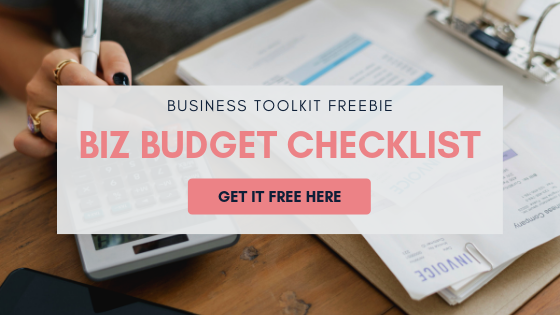The 5 Numbers You Need to Know to Run a Successful Business

Unless you’re a numbers geek (like me), I’ve found that most new business owners avoid talking about the numbers as much as possible. Running a successful business is the main goal and starting it is just the first hurdle. There are so many more fun things to focus on when starting a business – pretty logos and business cards and the website, oh my!
But the numbers are important. As a business owner, it’s critical that you have a good grasp on what yours are the whole way through. If you don’t know your numbers, it’ll be hard for you to make smart decisions about your business. It’ll prevent you from growing and scaling in the most successful way possible.
To start off on the right foot, these are the 5 numbers you must know in your business:

#1: Your Runway
Simply put, your runway is how many months you have before you run out of money. This is a number you need to calculate both for you and your business. As a new business owner, you are likely not taking a salary (or much of one), so you’ll need to understand how many months you have before you need to bring in more income. And you’ll also need to understand how many months the business can sustain before it brings in any revenues.
How to calculate runway? It’s pretty simple.
For your personal runway calculation, take your personal assets (savings accounts, checking account, etc.) and add to it any income you will have coming in over the 12 months. For example, if you have $12,000 in your savings account and your spouse brings home $3,000/month, your total personal assets would be: $12,000 + ($3,000 x 12) = $48,000.
Next, take your total expenses over the next 12 months. This should include everything from your mortgage/rent to groceries to daycare; for non-recurring expenses such as property taxes or car maintenance, take the annual amount and divide by 12. Let’s say this number is $4,000/month.
To calculate your runway, take your personal assets number ($48,000) and divide it by your monthly expenses ($4,000). In this case, we get 12. This is the number of months you have before you run out of money, assuming you add no additional income and your expenses don’t increase or decrease.
*Keep in mind, this does not consider cash flow, meaning if you have enough cash on hand to pay your expenses, at any given point over those 12 months. We’ll talk about cash flow in another article, but if your expenses or other income fluctuates a lot each month, this is something you’ll want to be aware of.
Your company’s runway calculation is done the same way, except instead of your personal assets, you will calculate your company’s assets. Often times, this is very slow in the beginning and that’s okay. So let’s say you put $2,000 into your company to start, and currently you have expenses of $400 every month. Your company’s runway is 5 months.
Knowing these numbers is important. It tells you how much time you have before you need to make a change. I recommend making a calendar reminder to check in on your runway every month (it will change as your revenues and expenses do), and also a bigger check-in as you get close to the end of your runway. If you find you’re getting to the end and the money’s not flowing in, that’s a good time to re-evaluate and make some changes in your business.
#2: Your Burn Rate
Burn rate is very important for early-stage companies, as this is the rate at which your company is losing money. Most businesses aren’t profitable in the first few months, or even the first year or so. This amount tells you how much your company is actually losing each month.
There are two types of burn rate – gross burn and net burn. Gross burn is simply all of your company’s monthly expenses (again, for non-recurring expenses, take the annual amount and divide by 12), whereas net burn is your total monthly revenues minus your total monthly expenses (or in other terms, your net profit).
If you are just starting your business, you’ll have to estimate these amounts, and then continuously update them as your business grows. But knowing these two amounts is important – I’m amazed at how many companies I’ve seen don’t calculate these amounts and are then surprised at how much they are actually spending each month when they do.
If your burn rate is large (for example, if you are spending $5,000/month but you only estimate your monthly revenues to be $3,000 when you get up and running), you have an issue and you need to reevaluate your revenue model and your current expenses.
The goal, of course, is to have the smallest burn rate possible when you’re just starting out.
#3: Your Break-Even Point
Simply, your break-even point is the point at which your revenues and expenses are equal, so your revenues cover your costs, but no more – you aren’t making any profit. This is an important number to know because while we all go into business (hopefully) to make a profit, knowing the point you need to hit at which your company will at least be “paying for itself” is important.
One of the most common ways to calculate break-even point is in terms of sales volume. To do this, you need to know these three amounts:
Fixed Costs – these are costs that are not dependent on sales volume, such as the cost to run your website or your rent
Variable Costs – these are dependent on sales volume, such as the cost to produce a product or the costs to ship that product
Sales Price – the cost you will sell your product/service at
Here is the calculation for break-even point:
Break-Even Point = Fixed Costs / (Sales Price – Variable Costs)
For example, if you have a product you are selling for $50 that costs you $40 to make and your fixed costs are rent of $1,000 and salaries of $2,000 (total of $3,000), then you need to sell 300 units to break-even.
300 = $3,000 / ($50 – $40)
Knowing this will help you craft your sales goals as you are just starting out.
#4: Your Minimum Profit
This number goes along with your break-even point. Let’s say you calculated your break-even point above. You then realized that there was no way you were going to sell 300. What would you do?
Assuming your fixed costs couldn’t be decreased, you would need to examine your profit margin. To start, a few terms:
Profit ($) = Revenues – Expenses
Profit Margin (%) = Profit ¸ Revenues
If you weren’t going to be able to sell 300 units, you’d need to make more off the sale of each unit. In our example above, where the sales price is $50 and the costs to make each unit is $40, the profit is $10 and the profit margin is 20%. You now have two options. You can either decrease your cost to make each unit (perhaps through ordering more or finding a less expensive supplier), or raising the price.
So let’s say you thought selling 100 units was more reasonable. Using our break-even formula above, that would look like this:
100 = $3,000 / (Profit)
In this case, you would need profit of $30 per unit to cover your costs – this is your minimum profit. If you couldn’t reduce your costs of $40/unit, you would need to charge $70 each.
Even if you are not selling products and instead offer services, you should do these calculations too. For your costs to offer your product, you need to consider any supplies you use (notepads, presentation folders, etc.) as well as the value of your own time.
#5: Your Tax Rate
OK, I heard you groan. I know, I know, no one ever wants to talk about taxes. But they’re important, and as a new business owner, you absolutely need to think about that. The biggest mistake I’ve seen so many new business owners make is to ignore taxes. They then get a rude awakening a year later when they go to file their taxes and find out that not only do they owe a lot of money, but they’ve incurred penalties because they weren’t fulfilling their tax obligations throughout the year.
I’ll have another blog post on the different taxes you need to consider as a new business owner. For now, just be aware that there are multiple taxes that most business owners have to be aware of. These include, but are not limited to:
Federal income taxes
State income taxes
Other state taxes (franchise, excise, sales)
Local taxes
Payroll taxes
Property taxes
KNOW your tax rates. In all of the calculations we’ve done above, you should be including in your taxes as applicable. Without these numbers, your calculations will be grossly misrepresented and your business decisions will suffer as a result.
The Takeaway
Notice how I didn’t mention “revenues” as one of the 5 numbers you need to know when starting your business. Don’t get me wrong – revenues are important, BUT they are not everything. It can be very tough to estimate your revenues in the first year of business. Taking a conservative approach and planning on a low amount, and knowing the above amounts, which focus on stability and ability to survive, will take you a lot further in your business. If you take this in mind, you’ll be running a successful business before you know it.



